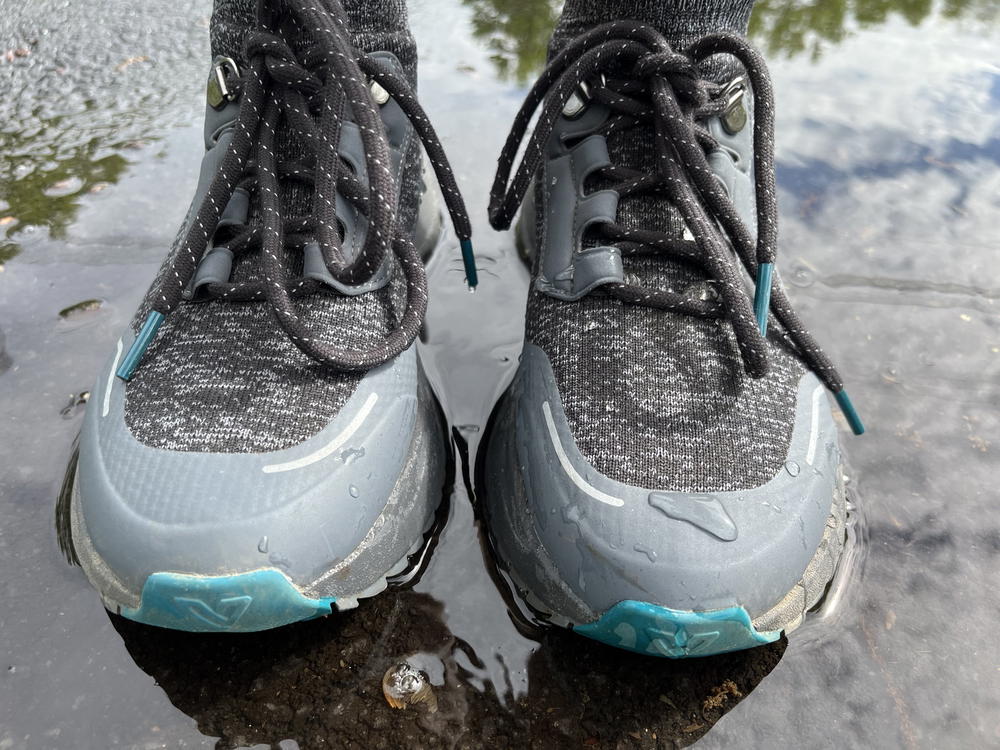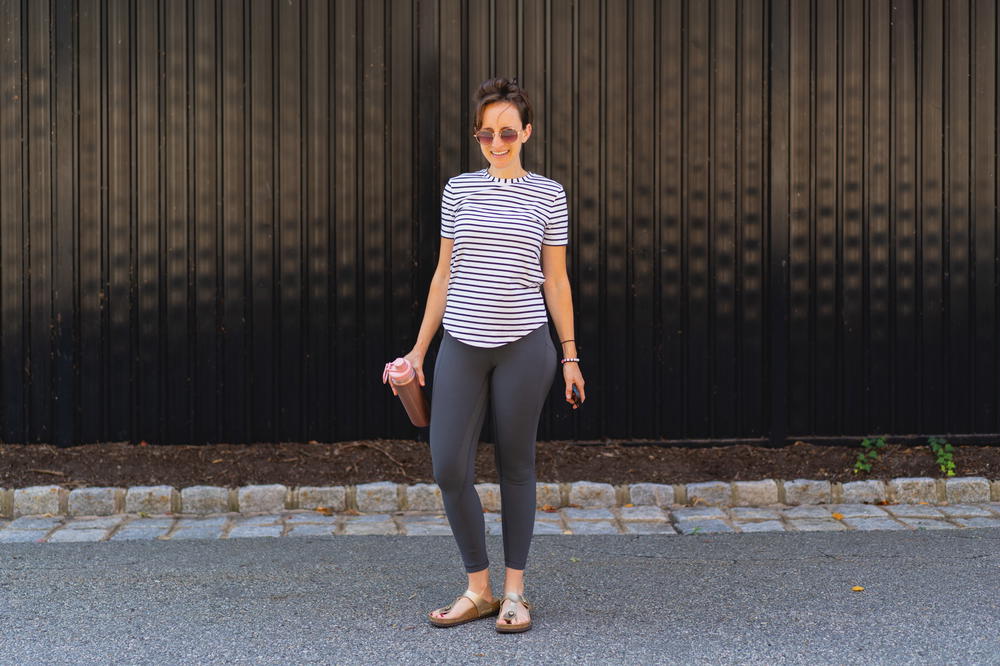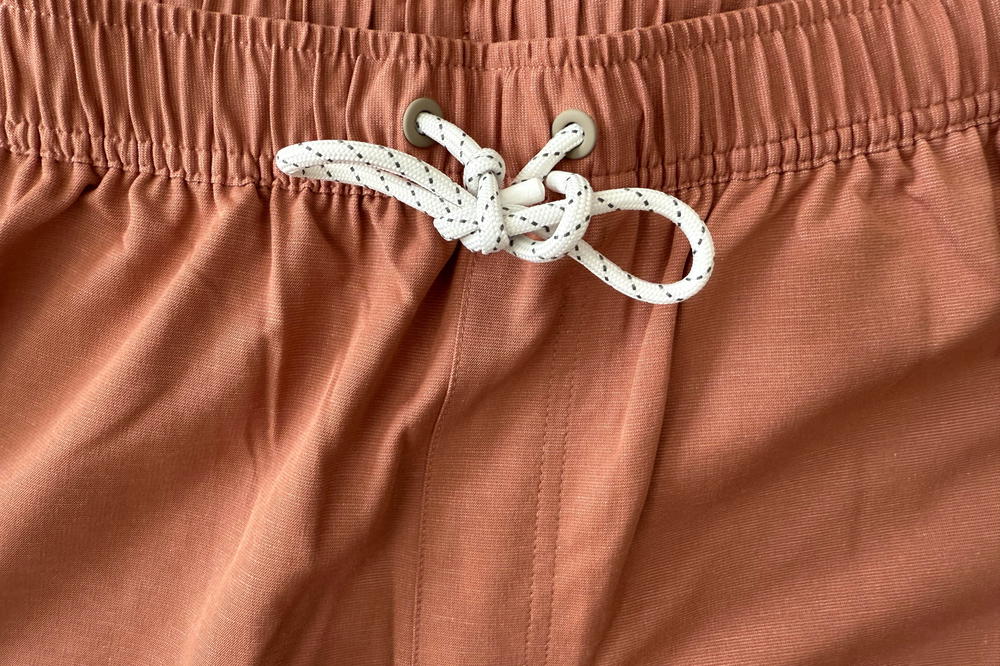Waterproof Shoes Review Criteria

See how we score waterproof shoes across detailed criteria with weighted ratings.
This article may contain affiliate links. We earn a small commissions when you purchase via those links — and it's free for you. It's only us (Becca & Dan) working on this website, so we value your support! Read our privacy policy and learn more about us.
Table of contents
- Scoring Overview
- All-day comfort (11%)
- Support & stability (9%)
- Fit & sizing consistency (7%)
- Breathability & moisture control (9%)
- Waterproof performance (18%)
- Thermal regulation (4%)
- Traction on different surfaces (11%)
- Weight & balance on foot (7%)
- Packability in luggage (7%)
- Durability over time (7%)
- Insole quality & replaceability (3%)
- Toe & upper protection (2%)
- Style & outfit versatility (7%)
- Overall value for price (4%)
- Related Reviews
- Where to go next
This page details the specific criteria we use when reviewing waterproof shoes. Each criterion has a weight that contributes to the overall score. Learn more about how our scoring system works.
Scoring Overview
Each criterion below is weighted as a percentage of the total score. We evaluate each product on a scale of 1 to 5 for every criterion, then multiply by the weight to calculate the final rating.
All-day comfort (11%)
Waterproof membranes often reduce comfort, so I’m digging deeper here. I’m evaluating cushioning tuned for long pavement walks, checking pressure distribution on the forefoot and heel. I’m testing reduced stiffness since membranes can make shoes rigid. I’m checking interior lining softness. I’m assessing comfort during foot swelling from long flights. I’m also testing blister avoidance in humid or wet conditions. Waterproof shoes must be as comfortable as non-waterproof travel shoes. The question is whether you can walk all day without wanting to take them off.
Support & stability (9%)
Waterproof shoes are often used in trickier weather, so stability is essential. I’m evaluating arch structure and long-walk support. I’m checking heel stability under uneven sidewalks. I’m testing lateral stability when dodging puddles or stepping on slick surfaces. I’m assessing midsole stiffness for wet terrain. I’m also checking ankle security in light hiking or city slopes. Support separates shoes that work for travel from shoes that work for errands.
Fit & sizing consistency (7%)
Waterproof shoes aren’t useful if they only fit perfectly at home. I’m evaluating how well the size matches expectations since sizing varies wildly between brands. I’m checking room for foot swelling on long flights because feet expand during travel days. I’m testing toe box comfort since cramped toes cause problems fast. I’m assessing fit across different foot widths. I’m also checking how the fit changes after hours of walking. Travel shoes must accommodate swelling, movement and long wear without causing problems.
Breathability & moisture control (9%)
This is critical and often weak in waterproof designs. Poor breathability is the number one complaint of waterproof shoes. I’m evaluating breathability of the membrane, comparing Gore-Tex, eVent and proprietary systems. I’m testing sweat management in humid climates. I’m checking moisture-wicking linings. I’m assessing whether they avoid that swampy foot feeling during warm weather. I’m also testing odor resistance. The question is how well the shoe vents during a city walk without trapping heat and moisture.
Waterproof performance (18%)
This is the defining feature of waterproof shoes. Travelers need consistent waterproofing across all weather scenarios. I’m evaluating true waterproofing versus water-resistant claims. I’m testing seam sealing quality. I’m checking tongue construction to see if it’s gusseted or not. I’m assessing protection against puddles and splashback. I’m testing performance during all-day rain. I’m checking drying time after full saturation. I’m evaluating water penetration at flex points. I’m also testing how warm they stay in cold rain. This is the confidence level of being able to walk through rainstorms without worrying about your feet getting soaked.
Thermal regulation (4%)
Waterproof shoes blur the line between insulated and breathable. I’m evaluating warmth during chilly rain. I’m testing whether they avoid overheating in humid climates. I’m checking how lining materials affect temperature comfort. The question is whether the shoe keeps you comfortable from cold rain to warm humid days while handling temperature shifts.
Traction on different surfaces (11%)
This is one of the most important categories for waterproof shoes. Slips in wet travel environments are common, so traction must be top-tier. I’m evaluating wet pavement grip, which is critical for safety. I’m testing cobblestone traction since many destinations use cobblestones. I’m checking performance on tile floors in restaurants and train stations. I’m assessing light trail or gravel grip. I’m testing slip resistance in rain. I’m also evaluating confidence walking quickly while carrying bags. Poor traction makes travel stressful and dangerous.
Weight & balance on foot (7%)
Waterproof shoes are often heavier, so I’m refining this category. Heavy shoes destroy long travel days. I’m evaluating overall walking weight after several hours of wear. I’m testing bulk versus nimbleness. I’m checking flexibility of the forefoot. I’m assessing stability without feeling clunky. I’m testing fatigue reduction on long days. Light waterproof shoes are a major advantage for travel.
Packability in luggage (7%)
A shoe that handles rain may reduce the need for extra pairs. I’m evaluating bulk inside a carry-on. I’m testing compressibility since many waterproof shoes are stiff. I’m checking whether one waterproof pair can replace two other shoes. I’m assessing weight impact on luggage limits. Travel shoes should pack efficiently without taking up valuable luggage space.
Durability over time (7%)
Waterproof performance declines over time, so I’m expanding this category. Durability determines how long waterproofing actually lasts. I’m evaluating membrane longevity. I’m testing sole wear under city-heavy travel. I’m checking upper abrasion resistance. I’m assessing seam durability. I’m testing water performance beyond the first few months of use. I’m also evaluating resistance to scuffs from buses, trains and curbs. Travel shoes face abuse that lifestyle sneakers never see.
Insole quality & replaceability (3%)
Many waterproof shoes succeed or fail based on insole quality. I’m evaluating removable insoles for custom orthotics since some travelers need specific support. I’m testing cushion longevity to see if the insoles compress quickly. I’m checking odor and moisture resistance because insoles trap smells fast. I’m assessing comfort tuning. Good insoles extend shoe life and improve comfort.
Toe & upper protection (2%)
Travelers kick curbs and escalators more often than people realize. I’m evaluating reinforced toe bumper quality. I’m testing protection while moving luggage. I’m checking structure that prevents upper collapse. This is a subtle but important travel detail that affects long-term durability.
Style & outfit versatility (7%)
Waterproof shoes often look technical, so I’m refining this category. A waterproof shoe that looks good expands outfit options. I’m evaluating whether it works with jeans, chinos, casual pants and travel clothing. I’m checking if it looks overly like a hiking boot unless that’s the intent. I’m testing neutral, travel-friendly aesthetic. I’m assessing appropriateness in restaurants, museums and more formal settings. Travel shoes should blend into different environments without looking out of place.
Overall value for price (4%)
Where does this land on price versus what you’re actually getting? I’m evaluating longevity since waterproof shoes should last multiple trips. I’m testing waterproofing duration and how long the membrane actually performs. I’m checking replacement cost and comparing against competitor sets. I’m assessing whether the features justify the price tag. Build quality, durability and waterproof performance all factor into whether it’s worth the cost.
Related Reviews
Here are our reviews of waterproof shoes that use these scoring criteria:
- Vessi Stormburst Review: Waterproof Hiking Shoes Worth the Hype?
- Vessi Classic Chelsea Review: Waterproof Comfort for Cool Weather Travel
- Vessi Alta High Top Review: Cozy Winter Boot with Waterproof Protection
- Vessi Courtside Classic Review: Vintage-Inspired Waterproof Sneakers for Travel
- Vessi Weekend Sneaker Review: Lightweight Waterproof Comfort for Travel
Where to go next
- Return to the Review Scoring System overview
- Go to our Gear Reviews for everything that we’ve reviewed.
- Contact us or work with us.
🎒 Found the right gear?
We research and test the gear we recommend, so you can pack with confidence. If our suggestions improved your gear picks, treating us to a coffee keeps the reviews coming.
Help us test more gearYou may also like
-
![]()
14 Best Duffel Bags for Travel in 2025 (High Quality Options)
Is there a best duffel bag for travel? Check out my high-quality picks in outdoorsy duffels, classic carry-on duffels for flights and versatile weekender duffels.
-
![]()
Lululemon ABC Jogger Warpstreme Review: Polished Travel Joggers
I’ve worn the lululemon ABC Jogger Warpstreme on cross-country flights, office commutes and weekend errands. Here’s how the fit, fabric and pockets stack up.
-
![]()
12 Best Crossbody Bags for Travel: Lightweight & Anti-Theft Options
Discover the best crossbody bags for travel, from lightweight shoulder bags to anti-theft options. Perfect for women travelers who need hands-free convenience.
-
![]()
Lululemon Align High-Rise Pant Review: Buttery-Soft Travel Comfort
I review the lululemon Align High-Rise Pant 25 inch leggings, sharing why these buttery-soft Nulu fabric leggings are perfect for travel days and yoga classes. Are they the PERFECT leggings? They sure are close, as I see it.
-
![]()
Troubadour Apex Sling Review: A Minimal Carry for Travel or Biking
Troubadour’s Apex Sling is great for a biking commute for a travel day. In this review, I go through the standout features and I’ll let you know who this bag is really for.
-
![]()
Free Fly Men's Reverb Short Review: Do-It-All Travel Shorts
Free Fly's Reverb Shorts are awesome, for a few reasons. They don't wrinkle, they look good for casual occasions during my travels and they even work as a by-the-water choice. This honest review explains more.







